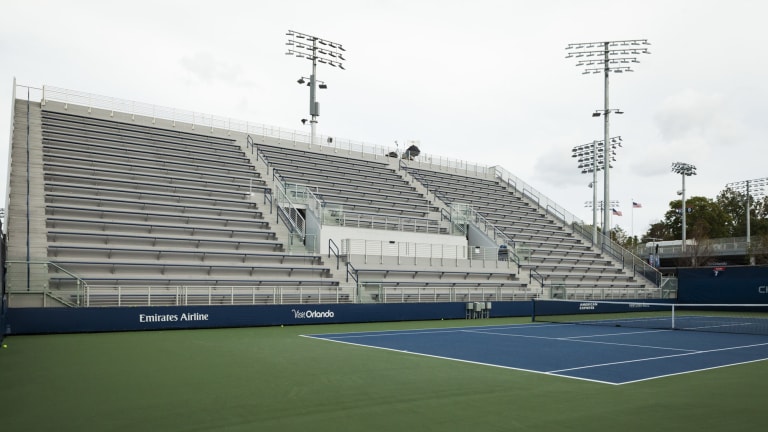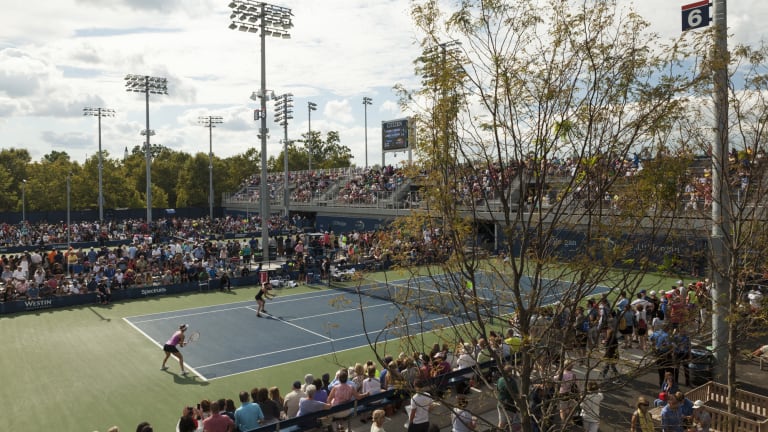Built in the southwest corner of the grounds near the new Grandstand, Court 7 is in an easily accessible location and has ample seating, with rafters that seem to touch the sky. What it lacks is any semblance of an atmosphere. During the first two days of last year’s tournament, when singles matches were plentiful, this court looked practically abandoned, bereft of energy. At one point I saw a man sleeping, or possibly planking, in the barren stands. The side closer to the Grandstand has some up-close views, but much of it is separated by a moat, without water. Water would have been a nice touch.
Lackluster scheduling doesn’t help this court’s cause, but regardless, it is the worst court at the U.S. Open.
Before the current Court 17 was built, there was another Court 17. Wedged into a remote part of the grounds, it was a forgotten rectangle, drawing few fans and forgettable match-ups. You can say the same for the today’s Court 16, which is used mainly for practice sessions. It’s wouldn’t make the cut for a Not For Tourists book about the U.S. Open.
This court looks similar to the adjacent Court 11, which attracts sizable first-week crowds. But 12 is no 11, as New York Rangers fans can attest. Still, this quiet venue has its plusses. Located near the claustrophobic food village, it’s a calm spot to relax and enjoy a midday snack or meal.
Embed from Getty Images
The old Louie hosted its final matches last year, giving this once-grand court a much-needed dose of nostalgia. (This year, a temporary stadium was constructed in a former parking lot.) When it was the center of attention at Flushing Meadows, Armstrong was loud and overflowing with fans—some classic YouTube clips remind me of a college-football game. But Armstrong long outlived its heyday. Most fans sat far away from the action, and only during the middle rounds, when grounds-pass holders have no other options for singles play, did it really come alive. Its long overdue rebuild, combined with the inflexible Arthur Ashe Stadium, gives the USTA a chance to make the new Louie the best U.S. Open court of all. Anything less would be a disappointment.
If you visit the Open during the first four days of the tournament, be sure to stop by this hidden gem. You can watch tennis from the stands, or by standing on the opposite pathway. The schedule-makers seem to like Court 11 as well; it draws some of the loudest first-week crowds.
This trio of side courts is ideal for wandering. If the match in front of you isn’t fitting your bill, you don’t have to walk far to find another. But no matter which court you end up at, you’ll be able to watch the action from up close. There’s little in way of actual seating, just a few bleachers and limited seating above one baseline. Behind the other baseline is Flushing Meadows-Corona Park. Here, you really feel part of Queens’ massive public greenspace. These courts can also be viewed from a perch in the new Grandstand.
Embed from Getty Images
See previous entry, for the layout is almost exactly the same. I give this trio the edge, though, because of what happened on Court 13 six years ago. Andy Roddick and David Ferrer were playing on Armstrong when a fissure in the playing surface was discovered, rendering the large court unplayable. Unwilling to wait for repairs, Roddick demanded to play on any available side court. The top American and the workmanlike Spaniard were sent to Court 13 to finish their fourth-round match. “At least there wasn’t a baby crying on the fence,” said Roddick, after playing his first singles match on the 584-seat venue since 1999.
Let me start with the positives. The “new” Grandstand is the centerpiece of a multi-year transformation of the National Tennis Center, and it gives fans a reason to visit the southwest part of the grounds. Once the hinterlands, this district is now a thriving scene. The new Grandstand is a beautiful, modern stadium that offers patrons a wide range of viewing perspectives for some of the day’s top singles matches, and it’s also very wheelchair-accessible. There is a concourse, plenty of fan-friendly amenities and space to escape from the bustle. (For more about the new Grandstand, read Steve Tignor's review from last year.)
Embed from Getty Images
The USTA got this one right, except for one notable misstep: reserved seating. The entire lower bowl of Grandstand is ticketed, which means we'll rarely see a truly full house—which was pretty much a guarantee from its predecessor. The new Grandstand has received rave reviews from players, fans and journalists, but the bubbling cauldron of excitement that was the old Grandstand cannot be replicated.
The roof has completely changed my perception of this massive edifice. There’s the obvious benefit of continuing play during inclement weather, but even when it’s nice out, the cover provides some much-needed shade. The stadium is still too big—over 23,000 people can be crammed inside—but the roof makes it feel smaller. Widespread renovations around the grounds make Ashe’s wrinkles are more noticeable than ever: in the nosebleeds, you can feel as if you're above LaGuardia; the aging concourse is dreadful; the stadium can be stifling in warm weather. But the best and biggest matches happen here, especially at night. I’ve always said to buy grounds passes during the first week of the U.S. Open. Now I can say, without reservation, that you should buy Ashe tickets during its second week.
Embed from Getty Images
OK, so the sunken seats along the sidelines are better in theory than they are in reality, and this 2,500-seat venue is begging for a proper name. (For Peter Bodo’s thoughts on that, read this year’s U.S. Open issue of TENNIS Magazine.) But I’m nitpicking here. This is now the most intimate court at Flushing Meadows, and since none of it is ticketed, everyone is welcome to partake. There’s not a bad seat in the house, it gets quality matches and there is easy means of egress. Although once you come into Court 17, you won’t want to leave.
It’s ironic that 4, 5 and 6 are the subway trains that comprise New York’s much-maligned Lexington Avenue line. The green-colored tentacle of the city’s archaic mass transit system is its most congested, according to a recent study in the *New York Times*, with riders whose “faces revealed a mix of misery and resignation.”
This 4-5-6 offers an infinitely more enjoyable experience. Built in time for the 2014 tournament, this standalone attraction foreshadowed greater changes to come, but still impress today. For one, there’s spacious elevated seating. From this perch, you can watch practice sessions behind you, a match below you, and additional action on the sides. At ground level, you can practically touch the players, and it’s not a hassle to find a seat. They are first come, first serve, but fans aren’t left to languish in a queue, wondering if or when they’ll ever get in. Everything inside this tennis oasis is open, as passersby will quickly discover. And if you need a break for any reason, shade is abundant inside a roomy, open-air hallway created by the very construction of these three courts.

